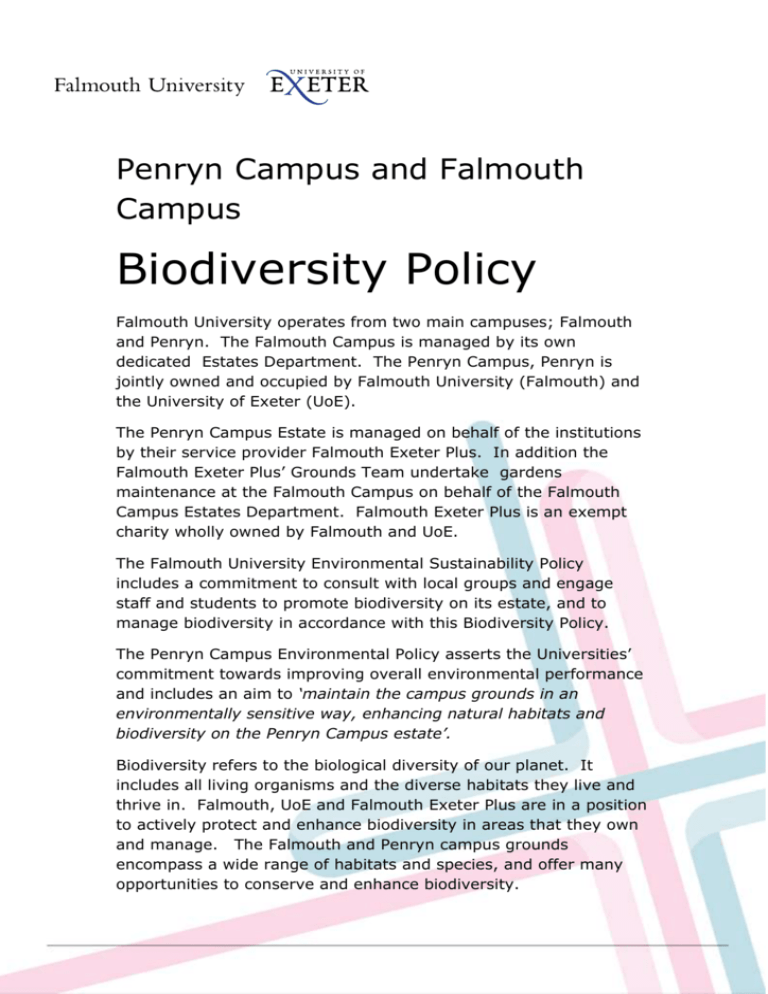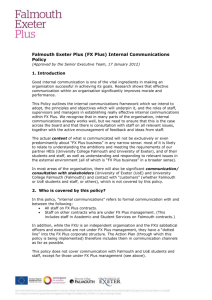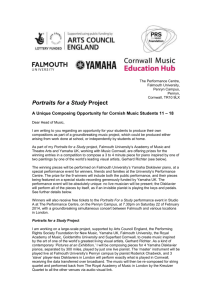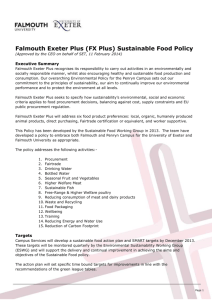- Falmouth Exeter Plus
advertisement

Penryn Campus and Falmouth Campus Biodiversity Policy Falmouth University operates from two main campuses; Falmouth and Penryn. The Falmouth Campus is managed by its own dedicated Estates Department. The Penryn Campus, Penryn is jointly owned and occupied by Falmouth University (Falmouth) and the University of Exeter (UoE). The Penryn Campus Estate is managed on behalf of the institutions by their service provider Falmouth Exeter Plus. In addition the Falmouth Exeter Plus’ Grounds Team undertake gardens maintenance at the Falmouth Campus on behalf of the Falmouth Campus Estates Department. Falmouth Exeter Plus is an exempt charity wholly owned by Falmouth and UoE. The Falmouth University Environmental Sustainability Policy includes a commitment to consult with local groups and engage staff and students to promote biodiversity on its estate, and to manage biodiversity in accordance with this Biodiversity Policy. The Penryn Campus Environmental Policy asserts the Universities’ commitment towards improving overall environmental performance and includes an aim to ‘maintain the campus grounds in an environmentally sensitive way, enhancing natural habitats and biodiversity on the Penryn Campus estate’. Biodiversity refers to the biological diversity of our planet. It includes all living organisms and the diverse habitats they live and thrive in. Falmouth, UoE and Falmouth Exeter Plus are in a position to actively protect and enhance biodiversity in areas that they own and manage. The Falmouth and Penryn campus grounds encompass a wide range of habitats and species, and offer many opportunities to conserve and enhance biodiversity. The management of biodiversity is being undertaken with the following objectives in mind: As far as is practicable, to conserve and enhance existing valuable habitats and to create new habitats across the Tremough university campus In partnership with FXU and the Student Union Eco-Society, to create a Biodiversity Action Plan containing up to date campus action recommendations, including specialist treatment and protection measures for known vulnerable species and habitats e.g. known otter and badger sites To comply with any relevant UK legislation regarding biodiversity To always consider ecological impacts and opportunities for ecological enhancement of any building refurbishments and any new building designs or construction activities To implement the Falmouth and PenrynCampus biodiversity management principles for Grounds/Estates (attached at appendix 1) To seek to work in partnership with environmental groups and outside organisations, to share knowledge and resources To seek funding and grants to facilitate these biodiversity aims and principles To involve staff, students and the local community in biodiversity issues through promoting and identifying opportunities for all to engage in volunteering and educational activity To use biodiversity to promote healthy living and wellbeing through improved outdoor amenity areas Report annually on performance. Appendix 1 – Falmouth and PenrynCampus Biodiversity Policy Biodiversity Management Principles for Falmouth Exeter Plus Grounds Team/Estates Department and Falmouth University Estates Department 1. Annually review management techniques to reduce the use of residual pesticides and increase the use of non-residual and biological/non-chemical control techniques e.g. use of bark mulch and natural predators 2. Identify and implement specialist treatments/protection measures for known vulnerable species e.g. otter, badger and bat sites. 3. Preserve the current practice of putting zero green waste to landfill 4. Introduce sympathetic management techniques e.g. leave ‘eco-strips’ near streams and watercourses, around woodland edges, and to create wildflower meadows to stimulate natural habitats 5. In order to protect nesting sites, no non-urgent felling works are to be carried out on trees during the bird nesting season (March to September). 6. Essential hedge maintenance shall only be undertaken after checking hedges to make sure nesting birds will not be disturbed by the proposed activity. 7. Leave habitat piles in appropriate areas to provide sources of food, shelter and hibernation sites. 8. In order to provide habitats for a variety of insect and bird life, to leave tree trunks standing (provided they are made safe) or leave tree trunks to decompose on the floor. 9. Erect bird and bat boxes at suitable locations throughout the campus and ensure they are monitored annually. 10. Continue to maintain beehives on the site. 11. Collect seeds from local native species to produce plants that are adapted to local eco-systems which can be used for shelterbelt thickening and woodland planting. 12. Encourage the use of green roofs wherever practicable to do so.








